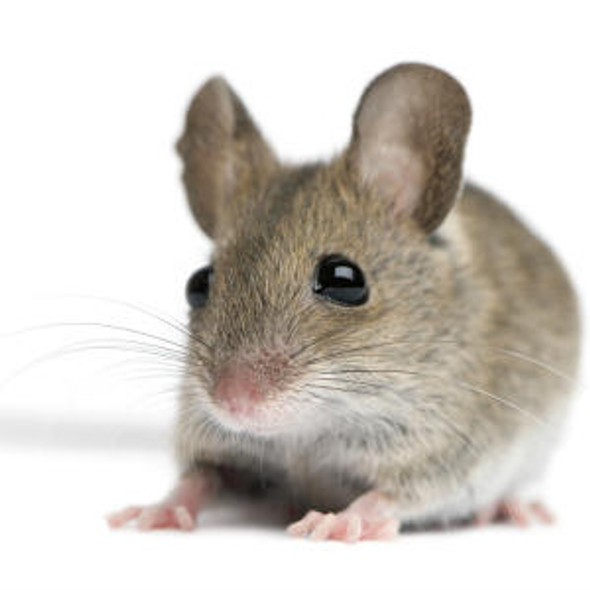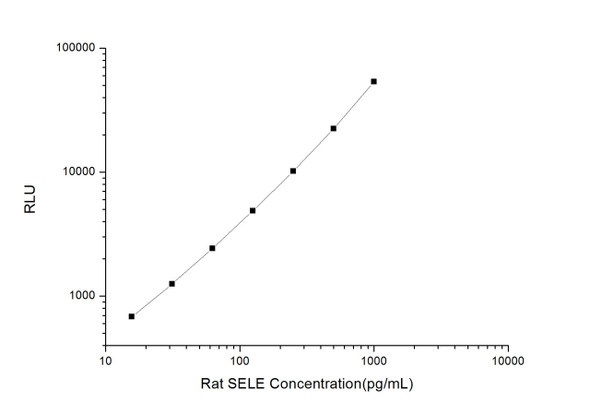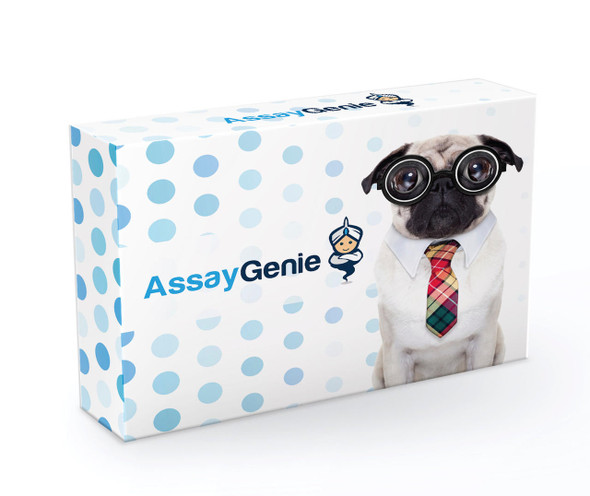Mouse Cell Biology ELISA Kits 2
Mouse SELE (E-Selectin) CLIA Kit (MOES00249)
- SKU:
- MOES00249
- Product Type:
- ELISA Kit
- ELISA Type:
- CLIA Kit
- Size:
- 96 Assays
- Sensitivity:
- 9.38pg/mL
- Range:
- 15.63-1000pg/mL
- ELISA Type:
- Sandwich
- Synonyms:
- CD62E, ELAM, ELAM1, ESEL, LECAM2
- Reactivity:
- Mouse
- Sample Type:
- Serum, plasma and other biological fluids
- Research Area:
- Cell Biology
Description
| Assay type: | Sandwich |
| Format: | 96T |
| Assay time: | 4.5h |
| Reactivity: | Mouse |
| Detection method: | Chemiluminescence |
| Detection range: | 15.63-1000 pg/mL |
| Sensitivity: | 9.38 pg/mL |
| Sample volume: | 100µL |
| Sample type: | Serum, plasma and other biological fluids |
| Repeatability: | CV < 15% |
| Specificity: | This kit recognizes Mouse SELE in samples. No significant cross-reactivity or interference between Mouse SELE and analogues was observed. |
This kit uses Sandwich-CLIA as the method. The micro CLIA plate provided in this kit has been pre-coated with an antibody specific to Mouse SELE. Standards or samples are added to the appropriate micro CLIA plate wells and combined with the specific antibody. Then a biotinylated detection antibody specific for Mouse SELE and Avidin-Horseradish Peroxidase (HRP) conjugate are added to each micro plate well successively and incubated. Free components are washed away. The substrate solution is added to each well. Only those wells that contain Mouse SELE, biotinylated detection antibody and Avidin-HRP conjugate will appear fluorescence. The Relative light unit (RLU) value is measured spectrophotometrically by the Chemiluminescence immunoassay analyzer. The RLU value is positively associated with the concentration of Mouse SELE. The concentration of Mouse SELE in the samples can be calculated by comparing the RLU of the samples to the standard curve.
| UniProt Protein Function: | SELE: Cell-surface glycoprotein having a role in immunoadhesion. Mediates in the adhesion of blood neutrophils in cytokine-activated endothelium through interaction with PSGL1/SELPLG. May have a role in capillary morphogenesis. Belongs to the selectin/LECAM family. |
| UniProt Protein Details: | Protein type:Membrane protein, integral Cellular Component: cortical cytoskeleton; extracellular space; membrane; perinuclear region of cytoplasm; integral to membrane; coated pit; caveola; lipid raft Molecular Function:phospholipase binding; transmembrane receptor activity; carbohydrate binding; sialic acid binding Biological Process: heterophilic cell adhesion; leukocyte adhesion; phospholipase C activation; positive regulation of leukocyte migration; positive regulation of receptor internalization; actin filament-based process; leukocyte tethering or rolling; cell adhesion; inflammatory response; signal transduction |
| UniProt Code: | Q00690 |
| NCBI GenInfo Identifier: | 266458 |
| NCBI Gene ID: | 20339 |
| NCBI Accession: | Q00690. 1 |
| UniProt Related Accession: | Q00690 |
| Molecular Weight: | |
| NCBI Full Name: | E-selectin |
| NCBI Synonym Full Names: | selectin, endothelial cell |
| NCBI Official Symbol: | Sele |
| NCBI Official Synonym Symbols: | Elam; CD62E; ELAM-1; LECAM2; E-selectin |
| NCBI Protein Information: | E-selectin |
| UniProt Protein Name: | E-selectin |
| UniProt Synonym Protein Names: | CD62 antigen-like family member E; Endothelial leukocyte adhesion molecule 1; ELAM-1; Leukocyte-endothelial cell adhesion molecule 2; LECAM2; CD_antigen: CD62E |
| Protein Family: | E-selectin |
| UniProt Gene Name: | Sele |
| UniProt Entry Name: | LYAM2_MOUSE |
As the RLU values of the standard curve may vary according to the conditions of the actual assay performance (e. g. operator, pipetting technique, washing technique or temperature effects), the operator should establish a standard curve for each test. Typical standard curve and data is provided below for reference only.
| Concentration (pg/mL) | RLU | Average | Corrected |
| 1000 | 51881 55469 | 53675 | 53650 |
| 500 | 20502 24476 | 22489 | 22464 |
| 250 | 10704 9718 | 10211 | 10186 |
| 125 | 4843 4959 | 4901 | 4876 |
| 62.5 | 2614 2292 | 2453 | 2428 |
| 31.25 | 1345 1217 | 1281 | 1256 |
| 15.63 | 660 756 | 708 | 683 |
| 0 | 24 26 | 25 | -- |
Precision
Intra-assay Precision (Precision within an assay): 3 samples with low, mid range and high level Mouse SELE were tested 20 times on one plate, respectively.
Inter-assay Precision (Precision between assays): 3 samples with low, mid range and high level Mouse SELE were tested on 3 different plates, 20 replicates in each plate.
| Intra-assay Precision | Inter-assay Precision | |||||
| Sample | 1 | 2 | 3 | 1 | 2 | 3 |
| n | 20 | 20 | 20 | 20 | 20 | 20 |
| Mean (pg/mL) | 46.98 | 128.16 | 383.97 | 45.05 | 119.39 | 354.84 |
| Standard deviation | 4.92 | 9.01 | 32.91 | 5.71 | 9.91 | 31.26 |
| C V (%) | 10.47 | 7.03 | 8.57 | 12.67 | 8.30 | 8.81 |
Recovery
The recovery of Mouse SELE spiked at three different levels in samples throughout the range of the assay was evaluated in various matrices.
| Sample Type | Range (%) | Average Recovery (%) |
| Serum (n=5) | 87-97 | 92 |
| EDTA plasma (n=5) | 87-98 | 92 |
| Cell culture media (n=5) | 88-101 | 93 |
Linearity
Samples were spiked with high concentrations of Mouse SELE and diluted with Reference Standard & Sample Diluent to produce samples with values within the range of the assay.
| Serum (n=5) | EDTA plasma (n=5) | Cell culture media (n=5) | ||
| 1:2 | Range (%) | 85-100 | 93-108 | 88-98 |
| Average (%) | 91 | 100 | 93 | |
| 1:4 | Range (%) | 103-117 | 98-115 | 90-102 |
| Average (%) | 110 | 106 | 96 | |
| 1:8 | Range (%) | 85-97 | 85-99 | 94-104 |
| Average (%) | 91 | 91 | 99 | |
| 1:16 | Range (%) | 92-105 | 92-107 | 97-110 |
| Average (%) | 98 | 98 | 104 |
An unopened kit can be stored at 4°C for 1 month. If the kit is not used within 1 month, store the items separately according to the following conditions once the kit is received.
| Item | Specifications | Storage |
| Micro CLIA Plate(Dismountable) | 8 wells ×12 strips | -20°C, 6 months |
| Reference Standard | 2 vials | |
| Concentrated Biotinylated Detection Ab (100×) | 1 vial, 120 µL | |
| Concentrated HRP Conjugate (100×) | 1 vial, 120 µL | -20°C(shading light), 6 months |
| Reference Standard & Sample Diluent | 1 vial, 20 mL | 4°C, 6 months |
| Biotinylated Detection Ab Diluent | 1 vial, 14 mL | |
| HRP Conjugate Diluent | 1 vial, 14 mL | |
| Concentrated Wash Buffer (25×) | 1 vial, 30 mL | |
| Substrate Reagent A | 1 vial, 5 mL | 4°C (shading light) |
| Substrate Reagent B | 1 vial, 5 mL | 4°C (shading light) |
| Plate Sealer | 5 pieces | |
| Product Description | 1 copy | |
| Certificate of Analysis | 1 copy |
- Set standard, test sample and control (zero) wells on the pre-coated plate and record theirpositions. It is recommended to measure each standard and sample in duplicate. Note: addall solutions to the bottom of the plate wells while avoiding contact with the well walls. Ensuresolutions do not foam when adding to the wells.
- Aliquot 100µl of standard solutions into the standard wells.
- Add 100µl of Sample / Standard dilution buffer into the control (zero) well.
- Add 100µl of properly diluted sample (serum, plasma, tissue homogenates and otherbiological fluids. ) into test sample wells.
- Cover the plate with the sealer provided in the kit and incubate for 90 min at 37°C.
- Aspirate the liquid from each well, do not wash. Immediately add 100µL of BiotinylatedDetection Ab working solution to each well. Cover the plate with a plate seal and gently mix. Incubate for 1 hour at 37°C.
- Aspirate or decant the solution from the plate and add 350µL of wash buffer to each welland incubate for 1-2 minutes at room temperature. Aspirate the solution from each well andclap the plate on absorbent filter paper to dry. Repeat this process 3 times. Note: a microplatewasher can be used in this step and other wash steps.
- Add 100µL of HRP Conjugate working solution to each well. Cover with a plate seal andincubate for 30 min at 37°C.
- Aspirate or decant the solution from each well. Repeat the wash process for five times asconducted in step 7.
- Add 100µL of Substrate mixture solution to each well. Cover with a new plate seal andincubate for no more than 5 min at 37°C. Protect the plate from light.
- Determine the RLU value of each well immediately.






